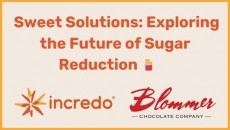Special edition: Natural sweeteners
Forget diet soda, stevia 3.0 is all about ‘re-inventing the regular’, says PureCircle

Speaking to FoodNavigator-USA as part our October special edition on natural sweeteners, PureCircle’s vice president global marketing & innovation Jason Hecker said:
“To consumers, there’s ‘diet’, which means compromise, and then there’s the world of sweet, which means joy and celebration, and not having to compromise.”
Stevia is being used in product areas that weren’t associated in the past with artificial sweeteners
And traditionally, he said, high intensity sweeteners have sat squarely in the ‘diet’ bracket, with a focus on diet soda.
By contrast, he said, “stevia sits in the world of sweet, which allows it to move into product areas that weren’t associated in the past with artificial sweeteners.
“So we’re seeing regular reformulation with perhaps a 10-20% reduction in sugar or HFCS, and products that are targeting families and children [as opposed to zero-calorie ‘diet products’ that have traditionally targeted women].
“Moms are open to the idea of natural calorie reduction and while beverages are still the key market, we’re seeing proliferation across categories from cereals, yogurts, bread and baked foods to table top sweeteners, ice cream and confectionery.”
Stevia today is not what was on the market three years ago
Meanwhile, the stevia products on the market now are very different from what was available even a couple of years ago, added Hecker.
“Stevia today is not what was on the market three years ago; we’ve made dramatic leaps in terms of quality.
“Stevia 1.0 was stevia extract, which was uncharacterized and variable. Then you had stevia 2.0, or high-purity Reb-A [steviol glycoside Rebaudioside-A], which was a consistent product. Now we have stevia 3.0, where we’re developing other ingredients from the leaf as well.
“We were the pioneers of high purity Reb-A, but we’ve since diversified into other natural sweeteners with SG95 (a combination of nine steviol glycosides that is 230 times sweeter than sugar); PureCircle Alpha (another combination of steviol glycosides with a ‘clean, sugar-like taste’); and Sweta (a blend of steviol glycosides up to 120 times sweeter than sugar).”
Vertical integration that really is what it says on the tin…
So what are food and beverage manufacturers looking for, and how are stevia suppliers differentiating themselves in the marketplace?
Customers want it all: A good price, reliable and consistent supplies, traceability, sustainability, applications expertise, a range of products, and control over the supply chain from field to fork, said Hecker.
In reality, however, many suppliers that say they are vertically integrated are in fact traders of stevia and contract out production to third parties, he claimed.
“From a supply perspective, you’ve got a number of smaller manufacturers of stevia and other ingredients, many of who are based in China, that don’t have the infrastructure to work directly with major customers and work instead with distributors.
“Then you have traders of stevia ingredients, large and small, that source from suppliers and manufacturers all over the world.
“Then you have us in the unique third position as a mainstream supplier geared up to deal with the world’s leading food and beverage companies. We own and control the supply chain from leaf to finished product and we are developing it on a mass scale.”
But he added: “It can be difficult to know what type of company you are dealing with.
“We encourage buyers to ask: Can I audit your supply chain? What’s your carbon and water footprint? How do you deal with your biomass? What quality tests are you doing? What’s your proven capacity? Can you trace your ingredients back to the farm? What do you mean when you say you ‘control’ your supply chain? We can answer all of these questions.”
We’ve made huge progress, it’s just not showing up in our figures yet…
PureCircle - which recently struck a deal with Coca-Cola to develop stevia sweeteners that could lead to a five-year supply deal - posted a 15% drop in 2012 revenues to $45.4m and a $15.2m operating loss.
However, the sales dip was “principally due to the continued impact of inventory at beverage global key accounts” said chairman Paul Selway-Swift, who noted that the new blends of steviol glycosides had performed well.
He added: “Volume increases were led by sales of the portfolio of proprietary new ingredients introduced over the past eighteen months… Reb A contributed just 40% of revenues in 2012 [vs 90% in 2009].”
Large scale adoption will be apparent during calendar years 2013 and 2014
Meanwhile, encouraging growth in usage suggested “large scale adoption will be apparent during calendar years 2013 and 2014”, he predicted, citing Datamonitor figures.
“Up to August 2012 food and beverage product launches with high purity stevia are running at a rate of 1,000 new launches for calendar 2012, a 65% increase over 2011. Longer term we remain confident that stevia will emerge as a major global industry.
"Our business model is designed for a mass volume natural sweetener market."


























